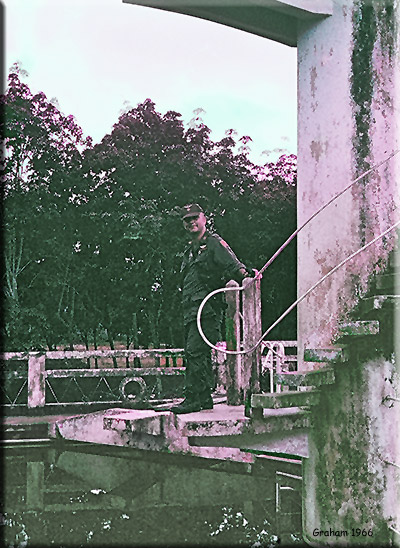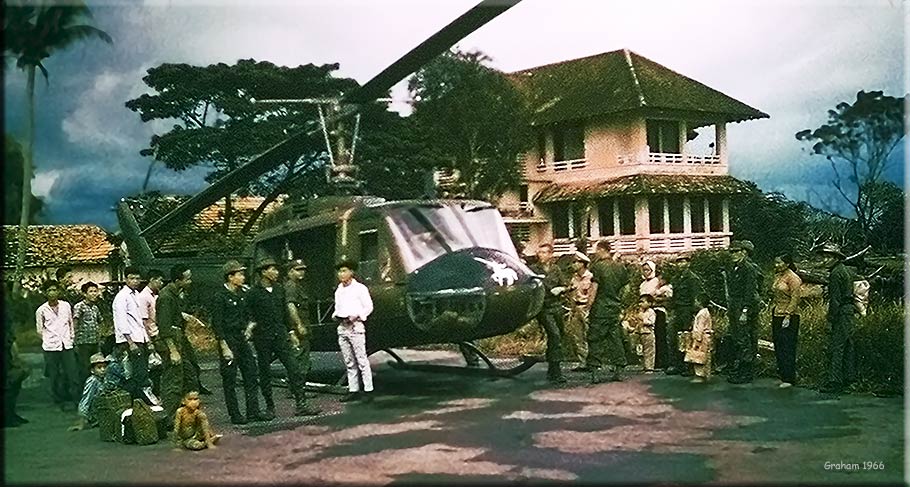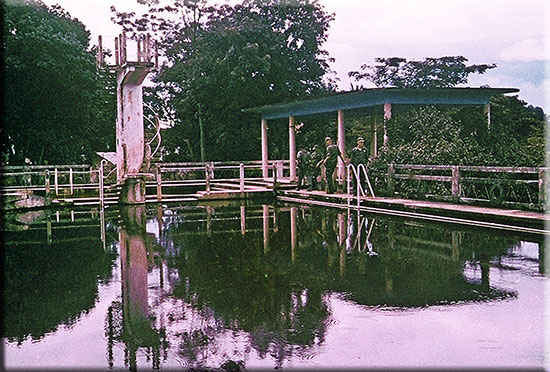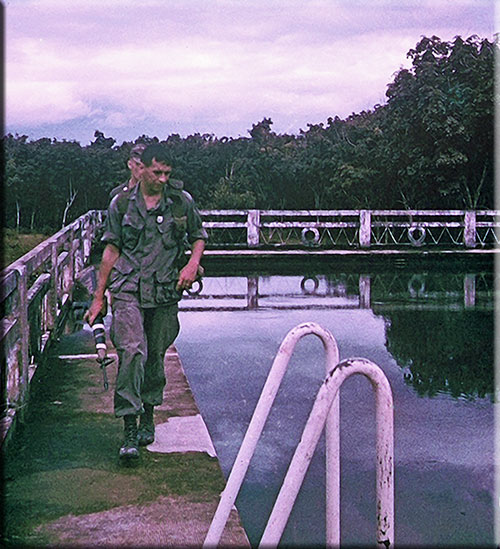

Training in the Michelin Pool - Sep 1966
A secure swampy place for training our Long Range Recon Patrol teams was needed. This is the story.
Please contact Bob Graham if you have comments or other input
During September 1966, preparing the Long Range Reconnaissance Patrol (LRRP) teams for in-water emersion familiarization and tactics was the training challenge of the moment.
The LRRP assigned with the D Troop Centaurs had a huge mission area within and, at times, beyond the 25th Infantry Division (ID) area of operation (AO). They could encounter a wide variation of jungle topography and other surface conditions. Not any mountains except Nui Ba Din, the Black Virgin, but lots of endurance and operational challenges spending three days covertly anywhere between dense jungle and open swamps. Their early training had been largely on dry land.
CPT Mark Ponzillo, the initial LRRP commander, had prepared the teams well. His five-man teams were harmonized to the rigors and discipline of covert operations and had trained extensively in the techniques of insertion and extraction by helicopter. The new commander, CPT Joseph Lacy, was continuing to add tactical and operational flexibility to the LRRP’s capabilities. The major concern was becoming accustomed to and enduring possible immersion for three day periods.
The immediate operational need was to improve the surveillance of the inundated areas in the swamp waterways and their connections to the 25th ID AO boundaries with the 1st ID along the Saigon River. It was a little difficult to train for this environment when the realistic training areas were free fire zones or often in the hands of the VC.
There were numerous details to get squared away and new procedures to practice: care of armament, radios, food, even going to the toilet. All those big and little things in a one’s daily cycle while operating under covert conditions. Not easy when all is considered in operating amongst the enemy and with all of the constraints to remain undetected. Acclimatization and practice were essential.
The iconic Michelin [including the Ben Cui area] Rubber Plantation remained in an operating state during the Vietnam War. There were airfields, multiple administrative areas, all fully staffed, and hundreds of workers of questionable loyalty. Who were all these workers? Established in 1925, it had grown to 31,000 acres, the largest in Vietnam and was one of France’s major Indo China exploitations.
Some of you aircrew members may remember pulling standby at Dau Tieng airfield (3rd Infantry Brigade AO) during late 1966 and have visions of a beautiful, fully functional swimming pool available for a refreshing dunk. The subject of this story was certainly not located there and was relatively a small swamp.
 The Centaur feature facility of interest at one of the smaller administrative areas with an airstrip was an unused, full-sized above ground concrete swimming pool.
The Centaur feature facility of interest at one of the smaller administrative areas with an airstrip was an unused, full-sized above ground concrete swimming pool.
The Centaurs and LRRP knew from experience that the VC continually operated in and around this portion of the immense plantation’s complexes. I had monitored a LRRP insertion on the operations radio taking place at the eastern edge of the plantation’s orderly rows of rubber trees. CPT Tony Robinson was escorting the insertion slick with a light fire team. Even though well planned with a rigorous prior reconnaissance, the touchdown point for the insertion slick was within the zone of fire of a well camouflaged VC manned bunker. We succeeded in zapping the bunker and expeditiously extracting the team. Although we did not suffer any casualties, it was a situation that we tried to avoid. The essence of this was if the Centaurs were to use the pool, we had to take control of the small airfield and plantation house residence area.
I personally wanted to insure that we were not starting a private war with the plantation by making a visit to warm up the plantation staff about the possible use of the pool. I have a photo of the parked operations slick with a mixed gathering of crew and Vietnamese. The plantation house is in the background. I remember having a couple of infantryman along, body guards of a sort, but we were quickly part of a small crowd near the slick. It was a little weird as I may have been the most uncomfortable member of the group. It was my first experience at finesse in commandeering foreign property.

 [CPT Lacy, myself, and a number of LRRP team leaders surveyed the structure during a short visit a few days later. Again we chatted with the friendly staff. Amazingly, many spoke quite understandable English with a nice French accent. They were cooperative and even a little apologetic about the condition of the swimming pool. Perhaps they thought we wanted to actually swim in the pool. It was radially apparent that they were operating on an austere budget due to the war. All things considered, we found that it best met our needs for training the LRRP teams. The plantation could easily be actively in VC land so D Troop would still have to provide security, but it would be easier here than in some remote swamp.]
[CPT Lacy, myself, and a number of LRRP team leaders surveyed the structure during a short visit a few days later. Again we chatted with the friendly staff. Amazingly, many spoke quite understandable English with a nice French accent. They were cooperative and even a little apologetic about the condition of the swimming pool. Perhaps they thought we wanted to actually swim in the pool. It was radially apparent that they were operating on an austere budget due to the war. All things considered, we found that it best met our needs for training the LRRP teams. The plantation could easily be actively in VC land so D Troop would still have to provide security, but it would be easier here than in some remote swamp.]
To CPT Joe Lacy and me the pool held an amazing, nearly closed ecosystem. Along with varying kinds of aquatic plant growth, in the rather clear water were a variety of little fish, frogs and snakes. Not to worry?
There was a minority LRRP opinion probably prompted by someone’s experience as a life guard. Their concern was that the pool had remained unused, full of water, for well over ten years and was unsanitary.
However, we wanted everyone to be comfortable with the site; after all we were dealing with double volunteers. I felt that with this narrow mindedness it was observed to be dirty water. After all swamp water is not crystal clear! We would continue to discuss the issue.
After Major Peterson, the D Troop commander, visited and reviewed it all, this was the place selected for the LRRP Team training. The swimming pool! Pretty poetic, with a nice classic storybook ring: training in an old, French Indo China setting, “The Michelin Rubber Plantation’s Swimming Pool.”
The strange stuff does not end here. Joe Lacy and I thought the pool’s eco mix was not only acceptable, but outstandingly realistic. We had a small natural swamp that was tactically defendable during training with our own troop resources. The most important aspect of the facility was that it allowed us to evaluate the various problems of a wet LRRP team for three to five days from the edge of the pool; conducting the experiments and equipment reviews of all the things that make for innovation without as many security constraints.
 [At daybreak on the big day for preparing the pool, I landed in a slick loaded with a half dozen LRRP members and the items needed for the preparation, accompanied by two slicks with PLT SGT Horner and two squads of aero rifles, all escorted by a light fire team. SGT Horner was to provide security for the day and make a defense plan for a three-to-four day LRRP team training session. I wished to control the area around the parked helicopters and pool without interfering with the normal cycle of the plantation.]
[At daybreak on the big day for preparing the pool, I landed in a slick loaded with a half dozen LRRP members and the items needed for the preparation, accompanied by two slicks with PLT SGT Horner and two squads of aero rifles, all escorted by a light fire team. SGT Horner was to provide security for the day and make a defense plan for a three-to-four day LRRP team training session. I wished to control the area around the parked helicopters and pool without interfering with the normal cycle of the plantation.]
The contentious issue boiled down to sanitizing the pool. You all still want to sanitize the pool? This was incredible. It was so absolutely ridiculous. We were striving for authenticity, and they wanted to sanitize the training site. Joe and I really lost the argument to the keep-it-clean-and-sanitary people who argued that mixing a few pounds of lime into the pool would be sufficient.
As I watched, the crew distributed a bag of lime across the surface, and the appearance of the pool did change. The mixing, just throw in a couple of concussion grenades! “Come on. Let’s be realistic,” they said, “A grenade is no big thing, and it will just mix the lime quickly.”
Then, without fanfare, someone popped a grenade and tossed it into the center of the pool. We all flattened and whoomp! It was only a little geyser, but there was a boiling of nature’s orderly system. Decades of accumulated sediment, vegetation, and dead frogs floated to the surface, and little stunned fish rapidly swam in circles. Oh well, so much for the natural ecosystem concept.
In the end, about 300 pounds of lime and six concussion grenades later, they were satisfied. What did we have? I thought it was uncooked natural chowder. It was an unusable mess! It took hours to settle and for the entire dying aquatic life to pass away. The pool had to be skimmed of the organic mess. Oh, there was some great stuff to scoop off the top of that big Michelin concrete pot. The water may have been sanitized, but it was surely not clear clean water. Then we were ready to conduct the training.
In retrospect, history tells us that during the Vietnam War the production of raw rubber from the plantation was a significant source of income for the South Vietnamese Government. They paid taxes to the VC to continue to operate. In addition, the US Government was purported to have paid whenever it damaged the valuable rubber trees. In modern times it might be called a local pay-to-fight tax. I now wonder if we had to pay for the use of the Michelin Swimming Pool.
Note:
See story in Carl Burns’ book (page 169), “The Smell From Hell Night Fisherman” about a wet LRRP mission of the type we were to train for in the story.